2020年高考英语考试大纲解读
- 格式:doc
- 大小:305.00 KB
- 文档页数:73
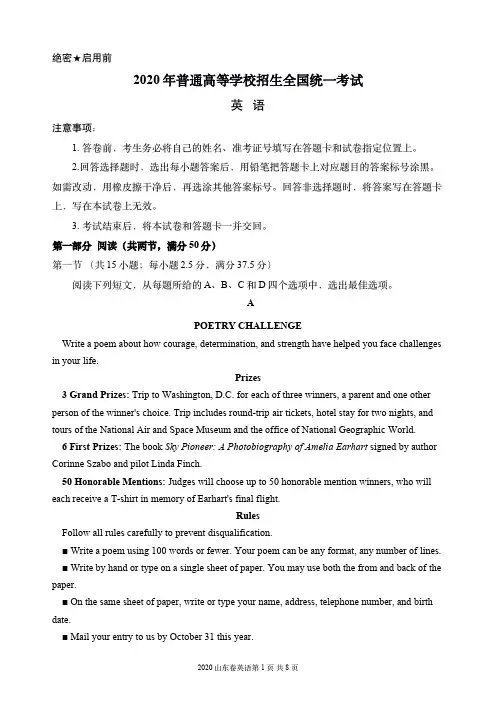
绝密★启用前2020年普通高等学校招生全国统一考试英语注意事项:1.答卷前,考生务必将自己的姓名、准考证号填写在答题卡和试卷指定位置上。
2.回答选择题时,选出每小题答案后,用铅笔把答题卡上对应题目的答案标号涂黑。
如需改动,用橡皮擦干净后,再选涂其他答案标号。
回答非选择题时,将答案写在答题卡上,写在本试卷上无效。
3.考试结束后,将本试卷和答题卡一并交回。
第一部分阅读(共两节,满分50分)第一节(共15小题;每小题2.5分,满分37.5分)阅读下列短文,从每题所给的A、B、C和D四个选项中,选出最佳选项。
APOETRY CHALLENGEWrite a poem about how courage,determination,and strength have helped you face challenges in your life.Prizes3Grand Prizes:Trip to Washington,D.C.for each of three winners,a parent and one other person of the winner's choice.Trip includes round-trip air tickets,hotel stay for two nights,and tours of the National Air and Space Museum and the office of National Geographic World.6First Prizes:The book Sky Pioneer:A Photobiography of Amelia Earhart signed by author Corinne Szabo and pilot Linda Finch.50Honorable Mentions:Judges will choose up to50honorable mention winners,who will each receive a T-shirt in memory of Earhart's final flight.RulesFollow all rules carefully to prevent disqualification.■Write a poem using100words or fewer.Your poem can be any format,any number of lines.■Write by hand or type on a single sheet of paper.You may use both the from and back of the paper.■On the same sheet of paper,write or type your name,address,telephone number,and birth date.■Mail your entry to us by October31this year.1.How many people can each grand prize winner take on the free trip?A.Two.B.Three.C.Four.D.Six.2.What will each of the honorable mention winners get?A.A plane ticket.B.A book by Corinne Szabo.C.A special T-shirt.D.A photo of Amelia Earhart.3.Which of the following will result in disqualification?A.Typing your poem out.B.Writing a poem of120words.ing both sides of the paper.D.Mailing your entry on October30.BJennifer Mauer has needed more willpower than the typical college student to pursue her goal of earning a nursing degree.That willpower bore fruit when Jennifer graduated from University of Wisconsin-Eau Claire and became the first in her large family to earn a bachelor's degree.Mauer,of Edgar,Wisconsin,grew up on a farm in a family of10children.Her dad worked at a job away from the farm,and her mother ran the farm with the kids.After high school,Jennifer attended a local technical college,working to pay her tuition(学费),because there was no extra money set aside for a college education.After graduation,she worked to help her sisters and brothers pay for their schooling.Jennifer now is married and has three children of her own.She decided to go back to college to advance her career and to be able to better support her family while doing something she loves: nursing.She chose the UW-Eau Claire program at Ministry Saint Joseph's Hospital in Marshfield because she was able to pursue her four-year degree close to home.She could drive to class and be home in the evening to help with her kids.Jennifer received great support from her family as she worked to earn her degree:Her husband worked two jobs to cover the bills,and her68-year-old mother helped take care of the children at times.Through it all,she remained in good academic standing and graduated with honors.Jennifer sacrificed(牺牲)to achieve her goal,giving up many nights with her kids and missing important events to study."Some nights my heart was breaking to have to pick between my kids and studying for exams or papers."she says.However,her children have learned an important lesson witnessing their mother earn her degree.Jennifer is a first-generation graduate and an inspiration to her family-and that's pretty powerful.4.What did Jennifer do after high school?A.She helped her dad with his work.B.She ran the family farm on her own.C.She supported herself through college.D.She taught her sisters and brothers at home.5.Why did Jennifer choose the program at Ministry Saint Joseph's Hospital in Marshfield?A.To take care of her kids easily.B.To learn from the best nurses.C.To save money for her parents.D.To find a well-paid job there.6.What did Jennifer sacrifice to achieve her goal?A.Her health.B.Her time with family.C.Her reputation.D.Her chance of promotion.7.What can we learn from Jennifer's story?A.Time is money.B.Love breaks down barriers.C.Hard work pays off.cation is the key to success.CIn the mid-1990s,Tom Bissell taught English as a volunteer in Uzbekistan.He left after seven months,physically broken and having lost his mind.A few years later,still attracted to the country,he returned to Uzbekistan to write an article about the disappearance of the Aral Sea.His visit,however,ended up involving a lot more than that.Hence this book,Chasing the Sea: Lost Among the Ghosts of Empire in Central Asia,which talks about a road trip from Tashkent to Karakalpakstan,where millions of lives have been destroyed by the slow drying up of the sea.It is the story of an American travelling to a strange land,and of the people he meets on his way: Rustam,his translator,a lovely24-year-old who picked up his colorful English in California, Oleg and Natasha,his hosts in Tashkent,and a string of foreign aid workers.This is a quick look at life in Uzbekistan,made of friendliness and warmth,but also its darker side of society.In Samarkand,Mr.Bissell admires the architectural wonders,while on his way to Bukhara he gets a taste of police methods when suspected of drug dealing.In Ferghana,he attends a mountain funeral(葬礼)followed by a strange drinking party.And in Karakalpakstan, he is saddened by the dust storms,diseases and fishing boats stuck miles from the sea.Mr.Bissell skillfully organizes historical insights and cultural references,making his tale a well-rounded picture of Uzbekistan,seen from Western eyes.His judgment and references are decidedly American,as well as his delicate stomach.As the author explains,this is neither a travel nor a history book,or even a piece of reportage.Whatever it is,the result is a fine and vivid description of the purest of Central Asian traditions.8.What made Mr Bissell return to Uzbekistan?A.His friends'invitation.B.His interest in the country.C.His love for teaching.D.His desire to regain health.9.What does the underlined word"that"in paragraph2refer to?A.Developing a serious mental disease.B.Taking a guided tour in Central Asia.C.Working as a volunteer in Uzbekistan.D.Writing an article about the Aral Sea.10.Which of the following best describes Mr Bissell's road trip in Uzbekistan?A.Romantic.B.Eventful.C.Pleasant.D.Dangerous.11.What is the purpose of this text?A.To introduce a book.B.To explain a cultural phenomenon.C.To remember a writer.D.To recommend a travel destination.DAccording to a recent study in the Journal of Consumer Research,both the size and consumption habits of our eating companions can influence our food intake.And contrary to existing research that says you should avoid eating with heavier people who order large portions (份),it's the beanpoles with big appetites you really need to avoid.To test the effect of social influence on eating habits,the researchers conducted two experiments.In the first,95undergraduate women were individually invited into a labto ostensibly(表面上)participate in a study about movie viewership.Before the film began,each woman was asked to help herself to a snack.An actor hired by the researchers grabbed her food first.In her natural state,the actor weighed105pounds.But in half the cases she wore a specially designed fat suit which increased her weight to180pounds.Both the fat and thin versions of the actor took a large amount of food.The participants followed suit,taking more food than they normally would have.However,they took significantly more when the actor was thin.For the second test,in one case the thin actor took two pieces of candy from the snack bowls. In the other case,she took30pieces.The results were similar to the first test:the participants followed suit but took significantly more candy when the thin actor took30pieces.The tests show that the social environment is extremely influential when we're making decisions.If this fellow participant is going to eat more,so will I.Call it the"I'll have what she's having''effect.However,we'll adjust the influence.If an overweight person is having a large portion,I'll hold back a bit because I see the results of his eating habits.But if a thin person eats a lot,I'll follow suit.If he can eat much and keep slim,why can't I?12.What is the recent study mainly about?A.Food safety.B.Movie viewership.C.Consumer demand.D.Eating behavior.13.What does the underlined word''beanpoles"in paragraph1refer to?A.Big eaters.B.Overweight persons.C.Picky eaters.D.Tall thin persons.14.Why did the researchers hire the actor?A.To see how she would affect the participants.B.To test if the participants could recognize her.C.To find out what she would do in the two tests.D.To study why she could keep her weight down.15.On what basis do we"adjust the influence"according to the last paragraph?A.How hungry we are.B.How slim we want to be.C.How we perceive others.D.How we feel about the food.第二节(共5小题;每小题2.5分,满分12.5分)阅读下面短文,从短文后的选项中选出能填入空白处的最佳选项。

高考考试大纲(课标实验版)——英语Ⅰ考试性质普通高等学校招生全国统一考试是合格的高中毕业生和具有同等学力的考生参加的选拔性考试。
高等学校根据考生成绩,按已确定的招生计划,德、智、体全面衡量,择优录取。
因此,高考应具有较高的信度、效度,适当的难度和必要的区分度。
Ⅱ考试内容根据普通高等学校对新生文化素质的要求,依据中华人民共和国教育部2020年颁布的《普通高中课程方案(实验)》和《普通高中英语课程标准(实验)》,确定本学科考试内容。
一、语言知识要求考生掌握并能运用英语语音、词汇、语法基础知识以及所学功能意念和话题(见附录1—附录5),要求词汇量为3500左右。
(注:各省区可以根据本地实际情况在《考试说明》中对词汇量进行适当调整,但不得低于2000个单词;同时,应制订计划,在一定时间内分期、分批增加至3500个单词。
)二、语言运用1.听力要求考生能听懂所熟悉话题的简短独白和对话。
考生应能:(1)理解主旨和要义;(2)获取具体的、事实性信息;(3)对所听内容作出推断;(4)理解说话者的意图、观点和态度。
2.阅读要求考生能读懂书、报、杂志中关于一般性话题的简短文段以及公告、说明、广告等,并能从中获取相关信息。
考生应能:(1)理解主旨和要义;(2)理解文中具体信息;(3)根据上下文推断生词的词义;(4)作出判断和推理;(5)理解文章的基本结构;(6)理解作者的意图、观点和态度。
3.写作要求考生根据题示进行书面表达。
考生应能:(1)清楚、连贯地传递信息,表达意思;(2)有效运用所学语言知识。
4.口语要求考生根据题示进行口头表达。
考生应能:(1)询问或传递事实性信息,表达意思和想法;(2)做到语音、语调自然;(3)做到语言运用得体;(4)使用有效的交际策略。
附录1 语音项目表1.基本读音(1)26个字母的读音(2)元音字母在重读音节中的读音(3)元音字母在轻读音节中的读音(4)元音字母组合在重读音节中的读音(5)常见的元音字母组合在轻读音节中的读音(6)辅音字母组合的读音(7)辅音连缀的读音(8)成节音的读音2.重音(1)单词重音3.读音的变化(1)连读(2)失去爆破(3)弱读(4)同化4.语调与节奏(1)意群与停顿(2)语调(3)节奏5.语音、语调、重音、节奏等在口语交流中的运用6.朗读和演讲中的语音技巧7.主要英语国家的英语语音差异附录2 语法项目表1.名词(1)可数名词及其单复数(2)不可数名词(3)专用名词(4)名词所有格2.代词(1)人称代词(2)物主代词(3)反身代词(4)指示代词(5)不定代词(6)疑问代词3.数词(2)序数词4.介词和介词短语5.连词6.形容词(比较级和最高级)7.副词(比较级和最高级)8.冠词9.动词(1)动词的基本形式(2)系动词(3)及物动词和不及物动词(4)助动词(5)情态动词10.时态(1)一般现在时(2)一般过去时(3)一般将来时(4)现在进行时(5)过去进行时(6)过去将来时(7)将来进行时(8)现在完成时(9)过去完成时(10)现在完成进行时11.被动语态12.非谓语动词(1)动词不定式(2)动词的-ing形式(3)动词的-ed形式13.构词法(1)合成法(2)派生法(3)转化法(4)缩写和简写14.句子种类(1)陈述句(2)疑问句(3)祈使句(4)感叹句15.句子成分(1)主语(2)谓语(3)表语(4)宾语(5)定语(6)状语(7)补语16.简单句的基本句型17.主谓一致18.并列复合句19.主从复合句(1)宾语从句(2)状语从句(3)定语从句(4)主语从句(5)表语从句20.间接引语21.省略22.倒装23.强调24.虚拟语气附录3 功能意念项目表1.社会交往(Social Communications)(1)问候(Greetings)(2)介绍(Introduction)(3)告别(Farewells)(4)感谢(Thanks)(5)道歉(Apologies)(6)邀请(Invitation)(7)请求允许(Asking for permission)(8)祝愿和祝贺(Expressing wishes and congratulations) (9)提供帮助(Offering help)(10)接受和拒绝(Acceptance and refusal)(11)约会(Making appointments)(12)打电话(Making telephone calls)(13)就餐(Having meals)(14)就医(Seeing the doctor)(15)购物(Shopping)(16)问路(Asking the way)(17)谈论天气(Talking about weather)(18)语言交际困难(Language difficulties in communication)(19)提醒注意(Reminding)(20)警告和禁止(Warning and prohibition)(21)劝告(Advice)(22)建议(Suggestions)2.态度(Attitudes)(23)同意和不同意(Agreement and disagreement) (24)喜欢和不喜欢(Likes and dislikes)(25)肯定和不肯定(Certainty and uncertainty) (26)可能和不可能(Possibility and impossibility) (27)能够和不能够(Ability and inability)(28)偏爱和优先选择(Preference)(29)意愿和打算(Intentions and plans)(30)希望和愿望(Hopes and wishes)(31)表扬和鼓励(Praise and encouragement)(32)责备和抱怨(Blame and complaint)(33)冷淡(Indifference)(34)判断与评价(Judgement and evaluation)3.情感(Emotions)(35)高兴(Happiness)(36)惊奇(Surprise)(37)忧虑(Worries)(38)安慰(Reassurance)(39)满意(Satisfaction)(40)遗憾(Regret)(41)同情(Sympathy)(42)恐惧(Fear)(43)愤怒(Anger)4.时间(Time)(44)时刻(Point of time)(45)时段(Duration)(46)频度(Frequency)(47)时序(Sequence)5.空间(Space)(48)位置(Position)(49)方向(Direction)(50)距离(Distance)6.存在(Existence)(51)存在与不存在(Existence and Non-existence) 7.特征(Features)(52)形状(Shape)(53)颜色(Colour)(54)材料(Material)(55)价格(Price)(56)规格(Size)(57)年龄(Age)8.计量(Measurement)(58)长度(Length)(59)宽度(Width)(60)高度(Height)(61)数量(Number)9.比较(Comparison)(62)同级比较(Equal comparison)(63)差别比较(Comparative and superlative) (64)相似和差别(Similarity and difference)10.逻辑关系(Logical relations)(65)原因和结果(Cause and effect)(66)目的(Purpose)11.职业(Occupations)(67)工作(Jobs)(68)单位(Employer)附录4 话题项目表1.个人情况(Personal information)2.家庭、朋友与周围的人(Family, friends and people around) 3.周围的环境(Personal environments)4.日常活动(Daily routines)5.学校生活(School life)6.兴趣与爱好(Interests and hobbies)7.个人感情(Emotions)8.人际关系(Interpersonal relationships)9.计划与愿望(Plans and intentions)10.节假日活动(Festivals, holidays and celebrations)11.购物(Shopping)12.饮食(Food and drink)13.健康(Health)14.天气(Weather)15.文娱与体育(Entertainment and sports)16.旅游和交通(Travel and transport)17.语言学习(Language learning)18.自然(Nature)19.世界与环境(The world and the environment)20.科普知识与现代技术(Popular science and mondern technology)21.热点话题(Topical issues)22.历史与地理(History and geography) 23.社会(Society)24.文学与艺术(Literature and art)附录5 词汇表(略)。
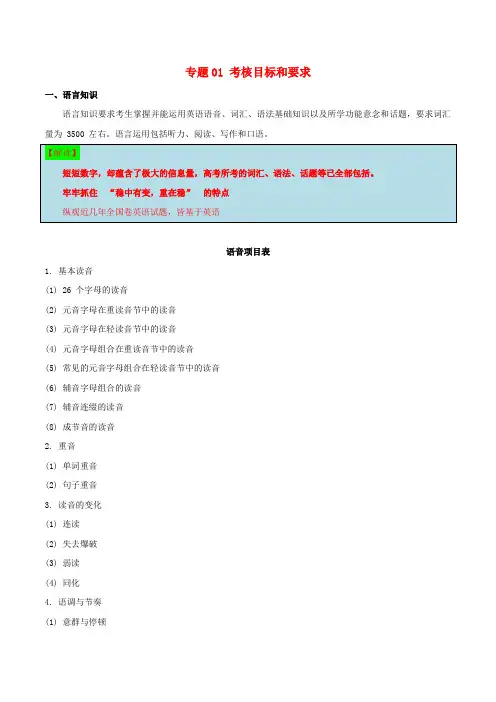
专题01 考核目标和要求一、语言知识语言知识要求考生掌握并能运用英语语音、词汇、语法基础知识以及所学功能意念和话题,要求词汇量为 3500 左右。
语言运用包括听力、阅读、写作和口语。
语音项目表1. 基本读音(1) 26 个字母的读音(2) 元音字母在重读音节中的读音(3) 元音字母在轻读音节中的读音(4) 元音字母组合在重读音节中的读音(5) 常见的元音字母组合在轻读音节中的读音(6) 辅音字母组合的读音(7) 辅音连缀的读音(8) 成节音的读音2. 重音(1) 单词重音(2) 句子重音3. 读音的变化(1) 连读(2) 失去爆破(3) 弱读(4) 同化4. 语调与节奏(1) 意群与停顿(2) 语调(3) 节奏5. 语音、语调、重音、节奏等在口语交流中的运用6. 朗诵和演讲中的语音技巧7. 主要英语国家的英语语音差异【解读】掌握英语语音对于听力理解和口语是非常重要的。
语法项目表1. 名词(1) 可数名词及其单复数(2) 不可数名词(3) 专有名词(4) 名词所有格2. 代词(1) 人称代词(2) 物主代词(3) 反身代词(4) 指示代词(5) 不定代词(6) 疑问代词3. 数词(1) 基数词(2) 序数词4. 介词和介词短语5. 连词6. 形容词(比较级和最高级)7. 副词(比较级和最高级)8. 冠词9. 动词(1) 动词的基本形式(2) 系动词(3) 及物动词和不及物动词(4) 助动词(5) 情态动词10. 时态(1) 一般现在时(2) 一般过去时(3) 一般将来时(4) 现在进行时(5) 过去进行时(6) 过去将来时(7) 将来进行时(8) 现在完成时(9) 过去完成时(10) 现在完成进行时11. 被动语态12. 非谓语动词(1) 动词不定式(2) 动词的-ing 形式(3) 动词的-ed 形式13. 构词法(1) 合成法(2) 派生法(3) 转化法(4) 缩写和简写14. 句子种类(1) 陈述句(2) 疑问句(3) 祈使句(4) 感叹句15. 句子成分(1) 主语(2) 谓语(3) 表语(4) 宾语(5) 定语(6) 状语(7) 补语16. 简单句的基本句型17. 主谓一致18. 并列复合句19. 主从复合句(1) 宾语从句(2) 状语从句(3) 定语从句(4) 主语从句(5) 表语从句20. 间接引语21. 省略22. 倒装23. 强调24. 虚拟语气功能意念项目表1. 社会交往 (Social Communications)(1) 问候 (Greetings)(2) 介绍 (Introduction)(3) 告别 (Farewells )(4) 感谢 (Thanks )(5) 道歉 (Apologies)(6) 邀请 (Invitation)(7) 请求允许 (Asking for permission)(8) 祝愿和祝贺 (Expressing wishes and congratulations)(9) 提供帮助 (Offering help)(10) 接受和拒绝 (Acceptance and refusal)(11) 约会 (Making appointments)(12) 打电话 (Making telephone calls)(13) 就餐 (Having meals)(14) 就医 (Seeing the doctor)(15) 购物 (Shopping)(16) 问路 (Asking the way)(17) 谈论天气 (Talking about weather)(18) 语言交际困难 (Language difficulties in communication)(19) 提醒注意 (Reminding)(20) 警告和禁止 (Warning and prohibition)(21) 劝告 (Advice)(22) 建议 (Suggestions)2. 态度 (Attitudes)(23) 同意和不同意 (Agreement and disagreement)(24) 喜欢和不喜欢 (Likes and dislikes)(25) 肯定和不肯定 (Certainty and uncertainty)(26) 可能和不可能 (Possibility and impossibility)(27) 能够和不能够 (Ability and inability)(28) 偏爱和优先选择 (Preference)(29) 意愿和打算 (Intentions and plans)(30) 希望和愿望 (Hopes and wishes)(31) 表扬和鼓励 (Praise and encouragement)(32) 责备和抱怨 (Blame and complaint)(33) 冷淡 (Indifference)(34) 判断与评价 (Judgement and evaluation)3. 情感 (Emotions)(35) 高兴 (Happiness)(36) 惊奇 (Surprise)(37) 忧虑 (Worries)(38) 安慰 (Reassurance)(39) 满意 (Satisfaction)(40) 遗憾 (Regret)(41) 同情 (Sympathy)(42) 恐惧 (Fear)(43) 愤怒 (Anger)4. 时间 (Time)(44) 时刻 (Point of time)(45) 时段 (Duration)(46) 频度 (Frequency)(47) 时序 (Sequence)5. 空间 (Space)(48) 位置 (Position)(49) 方向 (Direction)(50) 距离 (Distance)6. 存在 (Existence)(51) 存在与不存在 (Existence and Non-existence) 7. 特征 (Features)(52) 形状 (Shape)(53) 颜色 (Colour)(54) 材料 (Material)(55) 价格 (Price)(56) 规格 (Size)(57) 年龄 (Age)8. 计量 (Measurement)(58) 长度 (Length)(59) 宽度 (Width)(60) 高度 (Height)(61) 数量 (Number)9. 比较 (Comparison)(62) 同级比较 (Equal comparison)(63) 差别比较 (Comparative and superlative)(64) 相似和差别 (Similarity and difference)10. 逻辑关系 (Logical relations)(65) 原因和结果 (Cause and effect)(66) 目的 (Purpose)11. 职业 (Occupations)(67) 工作 (Jobs)(68) 单位 (Employer)话题项目表1. 个人情况 (Personal information)2. 家庭、朋友与周围的人 (Family, friends and people around)3. 周围的环境 (Personal environments)4. 日常活动 (Daily routines)5. 学校生活 (School life)6. 兴趣与爱好 (Interests and hobbies)7. 个人感情 (Emotions)8. 人际关系 (Interpersonal relationships)9. 计划与愿望 (Plans and intentions)10. 节假日活动 (Festivals, holidays and celebrations)11. 购物 (Shopping)12. 饮食 (Food and drink)13. 健康 (Health)14. 天气 (Weather)15. 文娱与体育 (Entertainment and sports)16. 旅游和交通 (Travel and transport)17. 语言学习 (Language learning)18. 自然 (Nature)19. 世界与环境 (The world and the environment)20. 科普知识与现代技术 (Popular science and modern technology)21. 热点话题 (Topical issues)22. 历史与地理 (History and geography)23. 社会 (Society)24. 文学与艺术 (Literature and art)词汇表(附后)二、语言运用1.听力要求考生能听懂所熟悉话题的简短独白和对话。
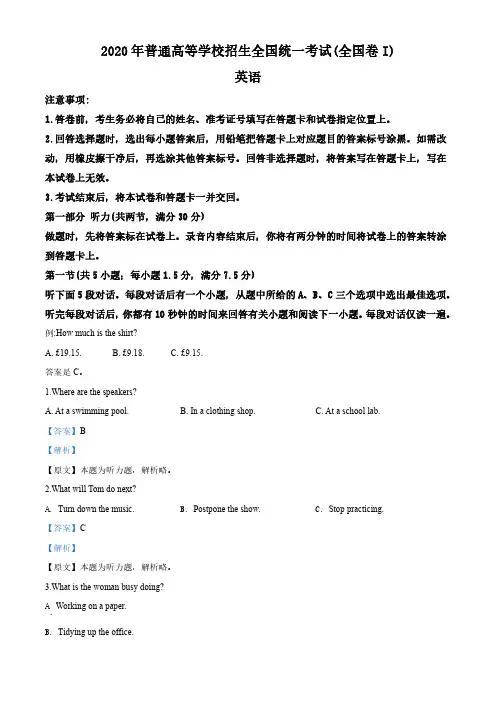
2020年普通高等学校招生全国统一考试(全国卷I)英语注意事项:1.答卷前,考生务必将自己的姓名、准考证号填写在答题卡和试卷指定位置上。
2.回答选择题时,选出每小题答案后,用铅笔把答题卡上对应题目的答案标号涂黑。
如需改动,用橡皮擦干净后,再选涂其他答案标号。
回答非选择题时,将答案写在答题卡上,写在本试卷上无效。
3.考试结束后,将本试卷和答题卡一并交回。
第一部分听力(共两节,满分30分)做题时,先将答案标在试卷上。
录音内容结束后,你将有两分钟的时间将试卷上的答案转涂到答题卡上。
第一节(共5小题;每小题1.5分,满分7.5分)听下面5段对话。
每段对话后有一个小题,从题中所给的A、B、C三个选项中选出最佳选项。
听完每段对话后,你都有10秒钟的时间来回答有关小题和阅读下一小题。
每段对话仅读一遍。
例:How much is the shirt?A.£19.15.B.£9.18.C.£9.15.答案是C。
1.Where are the speakers?A.At a swimming pool.B.In a clothing shop.C.At a school lab.【答案】B【解析】【原文】本题为听力题,解析略。
2.What will Tom do next?A.Turn down the music.B.Postpone the show.C.Stop practicing.【答案】C【解析】【原文】本题为听力题,解析略。
3.What is the woman busy doing?A.Working on a paper.B.Tidying up the office.anizing a party.【答案】C【解析】【原文】本题为听力题,解析略。
4.When will Henry start his vacation?A.This weekend.B.Next week.C.At the end of August.【答案】A【解析】【原文】本题为听力题,解析略。
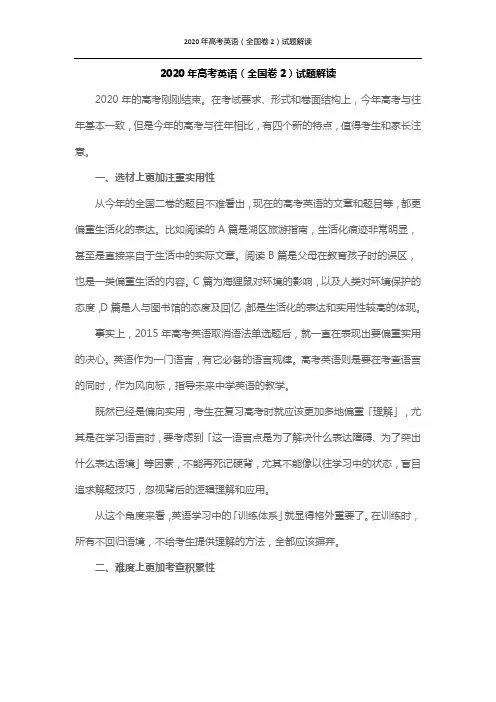
2020年高考英语(全国卷2)试题解读2020 年的高考刚刚结束。
在考试要求、形式和卷面结构上,今年高考与往年基本一致,但是今年的高考与往年相比,有四个新的特点,值得考生和家长注意。
一、选材上更加注重实用性从今年的全国二卷的题目不难看出,现在的高考英语的文章和题目等,都更偏重生活化的表达。
比如阅读的 A 篇是湖区旅游指南,生活化痕迹非常明显,甚至是直接来自于生活中的实际文章。
阅读 B 篇是父母在教育孩子时的误区,也是一类偏重生活的内容。
C 篇为海狸鼠对环境的影响,以及人类对环境保护的态度,D 篇是人与图书馆的态度及回忆,都是生活化的表达和实用性较高的体现。
事实上,2015 年高考英语取消语法单选题后,就一直在表现出要偏重实用的决心。
英语作为一门语言,有它必备的语言规律。
高考英语则是要在考查语言的同时,作为风向标,指导未来中学英语的教学。
既然已经是偏向实用,考生在复习高考时就应该更加多地偏重「理解」,尤其是在学习语言时,要考虑到「这一语言点是为了解决什么表达障碍、为了突出什么表达语境」等因素,不能再死记硬背,尤其不能像以往学习中的状态,盲目追求解题技巧,忽视背后的逻辑理解和应用。
从这个角度来看,英语学习中的「训练体系」就显得格外重要了。
在训练时,所有不回归语境,不给考生提供理解的方法,全都应该摒弃。
二、难度上更加考查积累性在全国二卷的七选五中,考查了表情符号这个很新鲜的事物。
不少考生反映「太难了」「看不懂」,尤其是这篇文章涉及教育问题。
阅读的 CD 两篇大家也有同样的困惑,因为这些事情比较抽象,涉及到的生词和陌生句式表达较多。
但事实上,这些内容的难度有两面性。
如果平时注意做积累训练的同学,会觉得相当简单。
不注重这些训练的同学,会觉得非常难。
值得一提的是,这里所谓的「积累训练」,仍然是「训练」,而不是盲目的积累。
以笔者的学生为例,他们在考试后纷纷发来微信:“刘旸老师/教主!这次的阅读好多都是训练过的!”这些学生用词是「训练」。

2020年高考冲刺试卷芳草香出品专题02 冠词【2020年高考考纲解读】冠词的考查几乎每年都有一两道题,而且基本都设两空。
一般情况下,试题的情景较为曲折,句式以复合句为主。
另外,在短文改错和语法填空中也常常涉及冠词的考查。
考查要点主要包括:1.考查定冠词和不定冠词的基本用法。
2.考查定冠词和不定冠词的特殊用法。
抽象名词具体化前冠词的使用情况、比较级前冠词的使用情况。
3.考查冠词的泛指、特指、类指和专指用法。
4.考查零冠词的运用。
另外,还涉及很多冠词与名词的固定搭配。
复习冠词须把握好以下三个原则:(1)单数可数名词用不定冠词a/an表示泛指;(2)复数可数名词及不可数名词表示泛指时,其前不加冠词;(3)无论可数名词还是不可数名词,表示特指时,其前都要加定冠词the。
【重点、难点剖析】一、定冠词1.表示特指。
Pass me the magazine on the desk.请把桌上的杂志递给我。
二、不定冠词1.泛指某一类人或物中的任何一个。
A teacher shouldn't talk like that.教师不应当那样讲话。
2.用于序数词前表示“又一”“再一”。
用于形容词最高级前意为“很,非常”。
We'll have to do it a second time.我们得再做一次。
He is a most wise man.他是一个十分明智的人。
3.用于具体化了的抽象名词前。
He was a success in business.他是事业成功人士。
4.在专有名词前表示“某一个”“类似的一个”。
A Mr. Smith wants to see you.一位史密斯先生想见你。
5.用于of短语中表示“同一”(=the same)。
Tom and Kate are of an age.汤姆与凯特同岁。
三、零冠词1.用于表示泛指或一般意义的物质名词、抽象名词、专有名词、复数名词等之前。
Knowledge begins with practice.知识从实践开始。
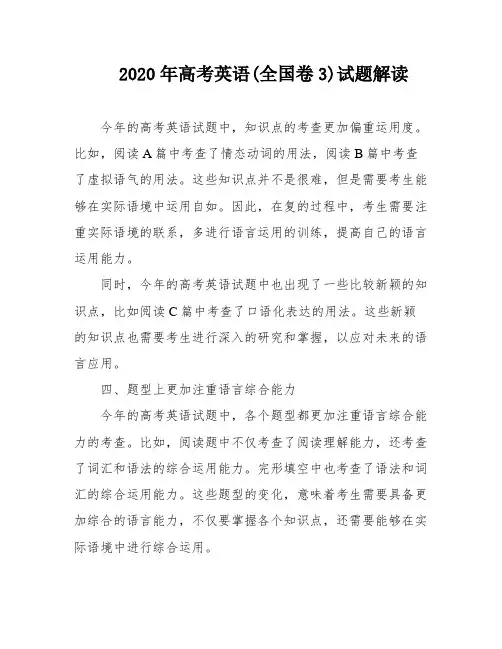
2020年高考英语(全国卷3)试题解读今年的高考英语试题中,知识点的考查更加偏重运用度。
比如,阅读A篇中考查了情态动词的用法,阅读B篇中考查了虚拟语气的用法。
这些知识点并不是很难,但是需要考生能够在实际语境中运用自如。
因此,在复的过程中,考生需要注重实际语境的联系,多进行语言运用的训练,提高自己的语言运用能力。
同时,今年的高考英语试题中也出现了一些比较新颖的知识点,比如阅读C篇中考查了口语化表达的用法。
这些新颖的知识点也需要考生进行深入的研究和掌握,以应对未来的语言应用。
四、题型上更加注重语言综合能力今年的高考英语试题中,各个题型都更加注重语言综合能力的考查。
比如,阅读题中不仅考查了阅读理解能力,还考查了词汇和语法的综合运用能力。
完形填空中也考查了语法和词汇的综合运用能力。
这些题型的变化,意味着考生需要具备更加综合的语言能力,不仅要掌握各个知识点,还需要能够在实际语境中进行综合运用。
因此,在复的过程中,考生需要注重语言能力的综合训练,多进行语言的综合运用训练,提高自己的语言综合能力。
同时,也需要注重语言思维的训练,提高自己的语言思维能力,更好地应对未来的语言应用。
今年全国三卷的写作考试题目涉及到了求助信的写作。
该题目的主题为请外教指导课本剧,考生需要补充短剧剧情、指导内容、修改要求、会面时间地点等。
这种题目形式对于不熟悉该话题的考生来说,可能很难有发挥的余地。
因此,考生在备考时应该注重对求助信的写作技巧的研究,理解其结构和内容要点。
同时,了解剧本写作的基本知识和技巧,以便能够更好地完成该题目。
此外,考生还需要注意题目中要求的各个方面的细节,如短剧剧情、指导内容、修改要求、会面时间地点等。
总之,考生在备考求助信的写作时,需要认真研究相关知识和技巧,掌握好题目要求的各个方面的细节,以便能够更好地完成考试。
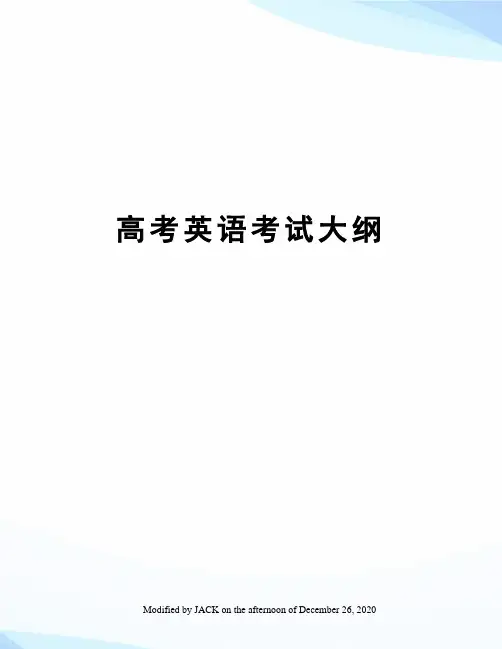
高考英语考试大纲 Modified by JACK on the afternoon of December 26, 2020英语考核目标与要求一、语言知识要求考生掌握并能运用英语语音、词汇、语法基础知识以及所学功能意念和话题(见附录1至附录5),要求词汇量为3500左右。
二、语言运用1.听力要求考生能听懂所熟悉话题的简短独白和对话。
考生应能:(1)理解主旨要义;(2)获取具体的、事实性信息;(3)对所听内容做出推断;(4)理解说话者的意图、观点和态度。
2.阅读要求考生能读懂书、报、杂志中关于一般性话题的简短文段以及公告、说明、广告等,并能从中获取相关信息。
考生应能:(1)理解主旨要义;(2)理解文中具体信息;(3)根据上下文推断单词和短语的含义;(4)做出判断和推理;(5)理解文章的基本结构;(6)理解作者的意图、观点和态度。
3.写作要求考生根据提示进行书面表达。
考生应能:(1)清楚、连贯地传递信息,表达意思;(2)有效运用所学语言知识。
4.口语要求考生根据提示进行口头表达。
考生应能:(1)询问或传递事实性信息,表达意思和想法;(2)做到语音、语调自然;(3)做到语言运用得体;(4)使用有效的交际策略。
附录1语音项目表1. 基本读音(1)26 个字母的读音(2)元音字母在重读音节中的读音(3)元音字母在轻读音节中的读音(4)元音字母组合在重读音节中的读音(5)常见的元音字母组合在轻读音节中的读音(6)辅音字母组合的读音(7)辅音连缀的读音(8)成节音的读音2. 重音(1)单词重音(2)句子重音3. 读音的变化(1)连读(2)失去爆破(3)弱读(4)同化4. 语调与节奏(1)意群与停顿(2)语调(3)节奏5.语音、语调、重音、节奏等在口语交流中的运用6.朗诵和演讲中的语音技巧7.主要英语国家的英语语音差异附录2语法项目表1. 名词(1)可数名词及其单复数(2)不可数名词(3)专有名词(4)名词所有格2. 代词(1)人称代词(2)物主代词(3)反身代词(4)指示代词(5)不定代词(6)疑问代词3. 数词(1)基数词(2)序数词4.介词和介词短语5.连词6.形容词(比较级和最高级)7.副词(比较级和最高级)8.冠词9.动词(1)动词的基本形式(2)系动词(3)及物动词和不及物动词(4)助动词(5)情态动词10. 时态(1)一般现在时(2)一般过去时(3)一般将来时(4)现在进行时(5)过去进行时(6)过去将来时(7)将来进行时(8)现在完成时(9)过去完成时(10)现在完成进行时11.被动语态12.非谓语动词(1)动词不定式(2)动词的-ing形式(3)动词的-ed形式13. 构词法(1)合成法(2)派生法(3)转化法(4)缩写和简写14. 句子种类(1)陈述句(2)疑问句(3)祈使句(4)感叹句15. 句子成分(1)主语(2)谓语(3)表语(4)宾语(5)定语(6)状语(7)补语16.简单句的基本句型17.主谓一致18.并列复合句19.主从复合句(1)宾语从句(2)状语从句(3)定语从句(4)主语从句(5)表语从句20.间接引语21.省略22.倒装23.强调24.虚拟语气附录3功能意念项目表1.社会交往(Social Communications)(1) 问候 (Greetings)(2) 介绍 (Introduction)(3) 告别 (Farewells )(4) 感谢 (Thanks )(5) 道歉 (Apologies)(6) 邀请 (Invitation)(7) 请求允许 (Asking for permission)(8) 祝愿和祝贺 (Expressing wishes and congratulations)(9) 提供帮助 (Offering help)(10) 接受和拒绝 (Acceptance and refusal)(11) 约会 (Making appointments)(12) 打电话 (Making telephone calls)(13) 就餐 (Having meals)(14) 就医 (Seeing the doctor)(15) 购物 (Shopping)(16) 问路 (Asking the way)(17) 谈论天气 (Talking about weather)(18) 语言交际困难 (Language difficulties in communication)(19) 提醒注意 (Reminding)(20) 警告和禁止 (Warning and prohibition)(21) 劝告 (Advice)(22) 建议 (Suggestions)2.态度(Attitudes)(23)同意和不同意(Agreement and disagreement)(24)喜欢和不喜欢(Likes and dislikes)(25)肯定和不肯定(Certainty and uncertainty)(26)可能和不可能(Possibility and impossibility)(27)能够和不能够(Ability and inability)(28)偏爱和优先选择(Preference)(29)意愿和打算(Intentions and plans)(30)希望和愿望(Hopes and wishes)(31)表扬和鼓励(Praise and encouragement)(32)责备和抱怨(Blame and complaint)(33)冷淡(Indifference)(34)判断与评价(Judgement and evaluation) 3. 情感(Emotions)(35)高兴(Happiness)(36)惊奇(Surprise)(37)忧虑(Worries)(38)安慰(Reassurance)(39)满意(Satisfaction)(40)遗憾(Regret)(41)同情(Sympathy)(42)恐惧(Fear)(43)愤怒(Anger)4. 时间 (Time)(44) 时刻 (Point of time)(45)时段(Duration)(46)频度(Frequency)(47)时序(Sequence) 5. 空间(Space)(48)位置(Position)(49)方向(Direction)(50)距离(Distance) 6. 存在(Existence)(51)存在与不存在(Existence and Non-existence)7. 特征(Features)(52)形状(Shape)(53)颜色(Colour)(54)材料(Material)(55)价格(Price)(56)规格(Size)(57)年龄(Age)8. 计量 (Measurement)(58)长度(Length)(59)宽度(Width)(60)高度(Height)(61)数量(Number)9. 比较(Comparison)(62)同级比较(Equal comparison)(63)差别比较(Comparative and superlative)(64)相似和差别(Similarity and difference)10. 逻辑关系 (Logical relations)(65)原因和结果(Cause and effect)(66)目的(Purpose)11. 职业 (Occupations)(67)工作(Jobs)(68)单位(Employer)附录4话题项目表1.个人情况(Personal information)2.家庭、朋友与周围的人(Family, friends and people around)3.周围的环境(Personal environments)4.日常活动(Daily routines)5.学校生活(School life)6.兴趣与爱好(Interests and hobbies)7.个人感情(Emotions)8.人际关系(Interpersonal relationships)9.计划与愿望(Plans and intentions)10.节假日活动(Festivals, holidays and celebrations)11.购物(Shopping)12.饮食(Food and drink)13.健康(Health)14.天气(Weather)15.文娱与体育(Entertainment and sports)16.旅游和交通(Travel and transport)17.语言学习(Language learning)18.自然(Nature)19.世界与环境(The world and the environment)20.科普知识与现代技术(Popular science and moderntechnology)21.热点话题(Topical issues)22.历史与地理(History and geography)23.社会(Society)24.文学与艺术(Literature and art)附录 5 词汇表A accommodation n a(an) art accompany v abandon v accomplish v ability n account nable a accountant n abnormal a accumulate v aboard prep accuracy n abolish v accurate a abortion n accuse vabout ad & prep accustomed a above prep,a & ad ache v & n abroad ad achieve v abrupt a achievement n absence n acid aabsent a acknowledge v absolute a acquaintance n absorb v acquire v abstract a & n acquisition n absurd a acre n abundant a across prep abuse v act n & v academic a & n action n academy n active a accelerate v activity n accent n actor n accept v actress n access n & v actual a accessible a acute a accident n AD abbrad=advertisement n afford vadapt v afraid a adaptation n Africa nadd v African a & n addicted a after ad,prep & conj addition n afternoon n address n afterward(s) ad adequate a again adadjust v against prep adjustment n age n administration n agency n admirable a agenda nadmire v agent n admission n aggressive a admit v ago ad adolescence n agree v adolescent a & n agreement n adopt v agricultural a adore v agriculture nadult n ahead ad advance v & n aid n & v advantage n AIDS n adventure n aim n & v advertise v air n advertisement n aircraft nadvice n airline nadvise v airmail n advocate v airplane naffair n airport naffect v airspace n affection n alarm n & valbum n amazing a alcohol n ambassador n alcoholic a & n ambassadress n algebra n ambiguous a alike ad ambition n alive a ambulance nall ad,a & pron America n allergic a among prep alley n amount n & v allocate v ample aallow v amuse v allowance n amusement n almost ad analyse valone a analysis n along ad & prep ancestor n alongside ad anchor v & n aloud ad ancient a alphabet n and conj already ad anecdote nalso ad anger n alternative a angle n although conj angry a altitude n animal n altogether ad ankle n aluminium anniversary n (Am aluminum) n announce v always ad annoy vam v(be) annual a./am,./AM abbr another a & pron amateur a answer n & v amaze v ant nAntarctic a appropriate a antique n approval n anxiety n approve v anxious a approximately ad any pron & a apron n anybody pron arbitrary a anyhow ad arch nanyone pron architect n anything pron architecture n anyway ad Arctic a anywhere ad are v(be)apart ad & a area n apartment n argue v apologize v argument n apology n arise(arose,arisen) v apparent a arithmetic n appeal v & n arm n & vappear v armchair n appearance n army n appendix n around ad & prep appetite n arrange v applaud v & n arrangement n apple n arrest v applicant n arrival n application n arrive vapply v arrow nappoint v art n appointment n article n appreciate v artificial a appreciation n artist n approach n & v as ad,conj & prepash n attend vashamed a attention nAsia n attitude nAsian a & n attract vaside ad attraction nask v attractive aasleep a audience naspect n aunt nassess v authentic aassessment n author nassist v authority nassistance n automatic aassistant n autonomous aassociate v autumn nassociation n available aassume v avenue nassumption n average a & nastonish v avoid vastronaut n awake(awoke,awoken) v & a astronomer n award nastronomy n aware aat prep away adathlete n awesome aathletic a awful aAtlantic a awkward aatmosphere natom n Battach v baby nattack v & n bachelor nattain v back ad,a & nattempt v & n background nbackward(s) ad basin nbacon n basis nbacterium(pl bacteria) n basket nbad(worse,worst) a basketball nbadminton n bat nbag n bath nbaggage n bathe vbakery n bathroom nbalance n bathtub nbalcony n battery nball n battle nballet n bay nballoon n BC abbrbamboo n be(am,is,are,was,ban n & v were,being,been) v banana n beach nband n bean nbandage n bean curd nbank n bear1 nbar n bear2 vbarbecue n beard nbarber n beast nbarbershop n beat(beat,beaten) v & n bare a beautiful abargain n & v beauty nbark v & n because conjbarrier n become(became,become) v base n bed nbaseball n beddings nbasement n bedroom nbasic a bee nbeef n bike=bicycle n beer n bill nbefore prep,ad&conj bingo nbeg v biochemistry n begin(began,begun) v biography n behalf n biology n behave v bird nbehaviour(Am behavior) n birth nbehind prep & ad birthday nbeing n birthplace nbelief n biscuit nbelieve v bishop nbell n bit nbelly n bite(bit,bitten) v belong v bitter abelow prep black a & nbelt n blackboard n bench n blame n & vbend(bent,bent) v blank n & a beneath prep blanket n beneficial a bleed vbenefit n & v bless vbent a & n blind abeside prep block n & v besides prep & ad blood nbetray v blouse n between prep blow(blew,blown) v beyond prep blue n & a bicycle n board n & vbid v & n boat nbig a body nboil v brain nbomb n & v brake n & vbond n & v branch nbone n brand nbonus n brave abook n & v bravery nboom n & v bread nboot n break(broke,broken) v & n booth n breakfast nborder n breakthrough nbored a breast nboring a breath nborn a breathe vborrow v breathless aboss n brewery nbotanical a brick nbotany n bride nboth a & pron bridegroom nbother v bridge nbottle n brief abottom n bright abounce v brilliant abound a bring(brought,brought) v boundary n broad abow v & n broadcast(broadcast,bowl n broadcast 或-ed,-ed) v bowling n brochure nbox n broken aboxing n broom nboy n brother nboycott v brown n & abrunch n Cbrush v & n cab nBuddhism n cabbage nbudget n cafe nbuffet n cafeteria nbuild(built,built) v cage nbuilding n cake nbunch n calculate v bungalow n call n & vburden n calm a & v bureaucratic a camel nburglar n camera nburn(burnt,burnt camp n & v或-ed,-ed) v & n campaign nburst v can1(could);bury v can’t=cannot modal vbus n can2 nbush n canal nbusiness n cancel vbusinessman/woman cancer n(pl businessmen/ women) n candidate nbusy a candle nbut conj & prep candy nbutcher n & v canteen nbutter n cap nbutterfly n capital nbutton n & v capsule nbuy(bought,bought) v captain nby prep caption nbye int car ncarbon ncard n ceiling ncare n & v celebrate vcareful a celebration n careless a cell ncarpenter n cent ncarpet n centigrade a carriage n centimetrecarrier n (Am centimeter) n carrot n central acarry v centre(Am center) n cartoon n century ncarve v ceremony ncase n certain acash n & v certificate n cassette n chain ncast(cast,cast) v chair ncastle n chairman/woman casual a (pl chairmen/women) n cat n chalk ncatalogue n challenge n catastrophe n challenging acatch(caught,caught) v champion n category n chance ncater v change n & v Catholic a changeable acattle n channel ncause n & v chant v & ncaution n chaos ncautious a chapter ncave n character nCD=compact disk n characteristic a & ncharge v & n Christmas n chart n church nchat n & v cigar ncheap a cigarette n cheat n & v cinema n check n & v circle n & v cheek n circuit n cheer n & v circulate v cheerful a circumstance n cheers int circus n cheese n citizen nchef n city n chemical a & n civil a chemist n civilian n chemistry n civilization n cheque(Am check) n clap vchess n clarify v chest n class nchew v classic a chicken n classify v chief a & n classmate n child(pl children) n classroom n childhood n claw n chocolate n clay n choice n clean v & a choir n cleaner n choke n & v clear a choose(chose,chosen) v clerk n chopsticks n clever a chorus n click v Christian n climate nclimb v come(came,come) v clinic n comedy nclock n comfort nclone v comfortable a close a & ad command n & v cloth n comment n clothes n commercial a clothing n commit vcloud n commitment n cloudy a committee nclub n common a clumsy a communicate v coach n communication n coal n communism n coast n communist n & a coat n companion n cocoa n company ncoffee n compare vcoin n compass n coincidence n compensate v coke n compete vcold a & n competence n collar n competition n colleague n complete a & v collect v complex a & n collection n component n college n composition n collision n comprehension n colour(Am color) n & v compromise v comb n & v compulsory a combine v computer nconcentrate v constant a concept n constitution n concern v & n construct v concert n construction n conclude v consult v conclusion n consultant n concrete a consume v condemn v contain v condition n container n conduct v contemporary a conductor n content1 n conference n content2 a confident a continent n confidential a continue v confirm v contradict v conflict n contradictory a confuse v contrary n & a congratulate v contribute v congratulation n contribution n connect v control v & n connection n controversial a conscience n convenience n consensus n convenient a consequence n conventional a conservation n conversation n conservative a convey v consider v convince v considerate a cook n & v consideration n cooker n consist v cookie n consistent a cool acopy n & v creature ncorn n credit ncorner n crew n corporation n crime ncorrect v & a criminal n correction n criterion(pl criteria) n correspond v crop ncorrupt a & v cross n & vcost n & v crossing ncosy(Am cozy) a crossroads n cottage n crowd n & vcotton n & a cruel acough n & v cry n & vcould modal v cube ncount v cubic acounter n cuisine ncountry n culture n countryside n cup ncouple n cupboard n courage n cure n & vcourse n curious acourt n currency n courtyard n curriculum n cousin n curtain ncover n & v cushion ncow n custom ncrash v & n customer ncrayon n customs ncrazy a cut(cut,cut) v & n cream n cycle vcreate v cyclist ndeclare vD decline vdad=daddy n decorate vdaily a,ad & n decoration ndam n decrease vdamage n & v deed ndamp a & n deep a & addance n & v deer ndanger n defeat v dangerous a defence(Am defense) n dare v & modal v defend vdark a & n degree ndarkness n delay n & vdash v & n delete v & ndata n deliberately ad database n delicate adate n & v delicious a daughter n delight ndawn n delighted aday n deliver vdead a demand vdeadline n dentist ndeaf a department(Dept.) n deal n departure ndear a depend vdeath n deposit v & n debate n & v depth ndebt n describe vdecade n description n decide v desert v & n decision n deserve vdesign v & n dilemma n desire v & n dimension n desk n dinner n desperate a dinosaur n dessert n dioxide n destination n dip vdestroy v diploma n detective n direct a & v determine v direction n develop v director n development n directory n devote v dirty a devotion n disability n diagram n disabled adial v disadvantage n dialogue(Am dialog) n disagree v diamond n disagreement n diary n disappear v dictation n disappoint v dictionary n disappointed a die v disaster ndiet n discount n differ v discourage v difference n discover v different a discovery n difficult a discrimination n difficulty n discuss vdig(dug,dug) v discussion n digest v disease n digital a disgusting a dignity n dish ndisk=disc ndislike vdismiss vdistance ndistant a distinction n distinguish v distribute vdistrict n disturbv disturbing adive v diverse a divide vdivision ndivorce v dizzya do(did,done)v doctor n document n dogndoll ndollar ndonate vdoor n dormitory(dorm)n dot ndouble a & n doubt n & v down prep & ad download n & v downstairs ad downtown ad,n & a dozen nDr=doctor ndraft n & vdrag vdraw(drew,drawn) v drawback n drawer ndream(dreamt,dreamt 或-ed,-ed) n & v dress n & vdrill n & vdrink(drank,drunk) v drive(drove,driven) v driver ndrop n & vdrug ndrum ndrunk adry v & aduck ndue adull adumpling nduring prepdusk ndust ndustbin ndusty aduty nDVD=digital versatile disk n elect vdynamic a electric a dynasty n electrical aelectricity nE electronic aeach a & pron elegant aeager a elephant neagle n else adear n e-mail n & v early a & ad embarrass vearn v embassy nearth n emergency n earthquake n emperor neast a,ad & n employ vEaster n empty aeastern a encourage veasy a encouragement n eat(ate,eaten) v end n & vecology n ending nedge n endless aedition n enemy neditor n energetic a educate v energy n education n engine n educator n engineer neffect n enjoy veffort n enjoyable aegg n enlarge v eggplant n enough pron,a & ad either a,conj & ad enquiry nelder n enter venterprise n everything pron entertainment n everywhere ad enthusiastic a evidence nentire a evident a entrance n evolution nentry n exact aenvelope n exam=examination n environment n examine venvy v & n example nequal a & v excellent a equality n except prepequip v exchange n & v equipment n excite veraser n excuse n & verror n exercise n & v erupt v exhibition n escape n & v exist vespecially ad existence nessay n exit nEurope n expand v European a & n expect vevaluate v expectation neven ad expense nevening n expensive aevent n experience n eventually ad experiment never ad expert nevery a explain v everybody pron explanation n everyday a explicit a everyone pron explode vexplore v fantastic aexport n & v fantasy nexpose v far(farther,farthestexpress v & n 或further,furthest) a & ad expression n fare nextension n farm nextra a farmer nextraordinary a fast a & adextreme a fasten veye n fat n & aeyesight n father nfault nF favour(Am favor) nface n & v favourite(Am favorite) a & n facial a fax n & vfact n fear nfactory n feast nfade v feather nfail v & n federal afailure n fee nfair1 a feed(fed,fed) vfair2 n feel(felt,felt) vfaith n feeling nfall1(fell,fallen) v fellow nfall2(Am)=autumn n female a & nfalse a fence nfamiliar a ferry nfamily n festival n & afamous a fetch vfan n fever nfancy n,v & a few pron & afibre(Am fiber) n flat2 nfiction n flee(fled,fled) vfield n flesh nfierce a flexible afight(fought,fought) n & v flight nfigure n & v float vfile n flood n & vfill v floor nfilm n & v flour nfinal a flow vfinance n flower nfind(found,found) v flu nfine1 a fluency nfine2 v fluent afinger n fly1(flew,flown) v fingernail n fly2 nfinish v & n focus v & nfire n & v fog nfireworks n foggy afirm1 n fold vfirm2 a folk n & afish n & v follow vfisherman n fond afist n food nfit a & v fool n & vfix v foolish aflag n foot(pl feet) nflame n football nflash n for prep & conj flashlight n forbid(forbade,forbidden) v flat1 a force vforecast n & v frequent a forehead n fresh aforeign a friction n foreigner n fridge=refrigerator n foresee(foresaw,foreseen) v friend nforest n friendly a forever ad friendship n forget(forgot,forgot/forgotten) v frighten v forgetful a frog nforgive(forgave,forgiven) v from prepfork n front a & nform n & v frontier nformat n frost nformer a fruit nfortnight n fry vfortunate a fuel nfortune n full aforward ad fun n & afoster v function n & v found v fundamental a fountain n funeral nfox n funny afragile a fur nfragrant a furnished a framework n furniture nfranc n future nfree afreedom n Gfreeway n gain vfreeze(froze,frozen) v gallery n freezing a gallon ngame n glue ngarage n go(went,gone) v garbage n goal ngarden n goat ngarlic n god ngarment n gold n & agas n golden agate n golf ngather v good(better,best) agay a goods ngeneral a & n goose(pl geese) n generation n govern vgenerous a government ngentle a grade ngentleman n gradual ageography n graduate vgeometry n graduation ngesture n grain nget(got,got) v gram ngift n grammar ngifted a grand agiraffe n grandchild ngirl n granddaughter ngive(gave,given) v grandma=grandmother n glad a grandpa=grandfather n glance v grandparents nglare v grandson nglass n granny nglobe n grape nglory n graph nglove n grasp vgrass n hair ngrateful a haircut ngravity n half a & ngreat a & ad hall ngreedy a ham ngreen a & n hamburger n greengrocer n hammer ngreet v hand n & vgreeting n handbag ngrey(Am gray) a handful ngrill n handkerchief ngrocer n handle n & vgrocery n handsome aground n handwriting ngroup n handy agrow(grew,grown) v hang(hung,hung 或-ed,-ed) v growth n happen vguarantee v happiness nguard n happy aguess v harbour(Am harbor) n guest n hard ad & aguidance n hardly adguide n hardship nguilty a hardworking aguitar n harm n & vgun n harmful agym=gymnasium n harmony ngymnastics n harvest n & vhat nH hatch vhabit n hate v & nhave(has,had,had) v hide(hid,hidden) vhe pron high a & adhead n & v highway nheadache n hill nheadline n him pron headmaster n himself pron headmistress n hire vhealth n his pronhealthy a history nhear(heard,heard) v hit(hit,hit) v & n hearing n hobby nheart n hold(held,held) vheat n hole nheaven n holiday nheavy a holy aheel n home n & adheight n homeland n helicopter n hometown nhello int homework nhelmet n honest ahelp n & v honey nhelpful a honour(Am honor) n & v hen n hook n & vher pron hope n & vherb n hopeful ahere ad hopeless ahero n horrible ahers pron horse nherself pron hospital nhesitate v host n & vhi int hostess nhot a identity n hotdog n identification n hotel n idiom nhour n if conjhouse n ignore v housewife n ill a housework n illegal ahow ad illness n however ad & conj imagine v howl v immediately ad hug v immigration n huge a import v & n human a & n importance n human being n important a humorous a impossible a humour(Am humor) n impress v hunger n impression n hungry a improve v hunt v in prep & ad hunter n inch n hurricane n incident n hurry v include vhurt(hurt,hurt) v income n husband n increase v & n hydrogen n indeed aindependence n I independent a I pron indicate vice n industry nice-cream n influence n & v idea n inform vinformation n interval ninitial a interview n & vinjure v into prepinjury n introduce vink n introduction ninn n invent vinnocent a invention ninsect n invitation ninsert v invite vinside prep & ad iron n & vinsist v irrigation ninspect v is v(be)inspire v island ninstant a it proninstead ad its proninstitute n itself proninstitution ninstruct v Jinstruction n jacket ninstrument n jam ninsurance n jar ninsure v jaw nintelligence n jazz nintend v jeans nintention n jeep ninterest n jet ninteresting a jewellery(Am jewelry) n international a job nInternet n jog vinterpreter n join vinterrupt v joke njournalist n kiss n & vjourney n kitchen njoy n kite njudge n & v knee njudgement knife(pl knives) n (Am judgment) n knock n & vjuice n know(knew,known) v jump n & v knowledge njungle njunior a Ljust a & ad lab=laboratory n justice n labour(Am labor) nlack n & vK lady nkangaroo n lake nkeep(kept,kept) v lamb nkettle n lame akey n lamp nkeyboard n land n & vkick v & n language nkid n lantern nkill v lap nkilo n large akilogram n last a & v kilometre(Am kilometer) n late a & adkind1 n latter nkind2 a laugh n & v kindergarten n laughter n kindness n laundry nking n law nkingdom n lawyer nlay(laid,laid) v lazy alead(led,led) v & n leader nleaf(pl leaves) n league nleak vlearn(learnt,learnt 或-ed,-ed)v least nleather nleave(left,left) v lecture nleft a,ad & nleg nlegal alemon n & a lemonade nlend(lent,lent) v length nlesson nlet(let,let) v letter nlevel n liberation n liberty n librarian n library nlicense nlid nlie1 n & v lie2(lay,lain) v life(pl lives) n lift v & nlight n,v & a lightning nlike v & prep likely alimit vline n & vlink v & nlion nlip nliquid n & alist n & vlisten v literature n literary alitre(Am liter) n litter vlittle(less,least) a live v & a lively aload nloaf nlocal alock n & v lonely along a & ad look n & v loose alorry nlose(lost,lost) v manage vloss n manager nlot n mankind nloud a manner nlounge n many(more,most) pron & a love n & v map nlovely a maple nlow a & ad marathon nluck n marble nlucky a march n & vluggage n mark n & vlunch n market nlung n marriage nmarry vM mask n & vmachine n mass nmad a master v & nmadam/madame n mat nmagazine n match v & nmagic a material nmaid n mathematicsmail n & v =math/maths nmailbox n matter n & vmain a mature amainland n maximum a & nmajor a may modal vmajority n maybe admake1 n me pronmake2(made,made) v meal nmale a & n mean(meant,meant) v man(pl men) n meaning nmeans n microwave nmeanwhile ad middle nmeasure v midnight nmeat n might modal vmedal n mild amedia n mile nmedical a milk n & vmedicine n millimetremedium n (Am millimeter) nmeet(met,met) v & n millionaire nmeeting n mind n & vmelon n mine1 n & vmember n mine2 pronmemorial n & a mineral nmemory n minibus nmend v minimum amental a minister nmention n & v ministry nmenu n minority nmerchant a & n minus prep & amerciful a minute nmercy n mirror nmerely ad miss1 nmerry a miss2 vmess n missile nmessage n mist nmessy a mistakemetal n & a (mistook,mistaken) v & n method n mistaken ametre(Am meter) n misunderstandmicroscope n (misunderstood,misunderstood) v。
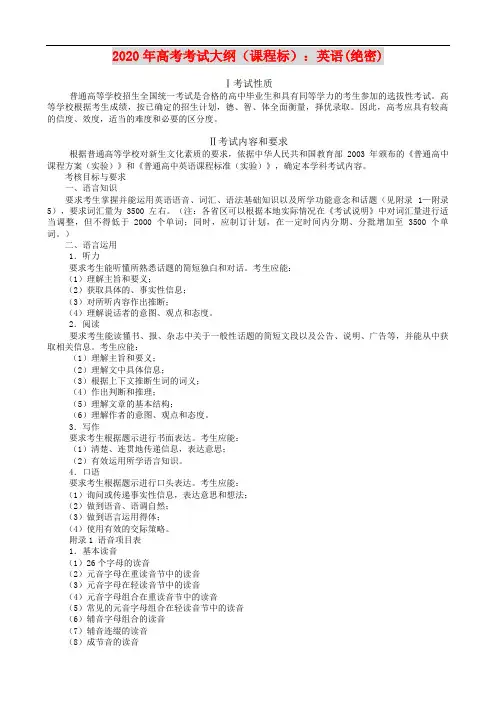
Ⅰ考试性质普通高等学校招生全国统一考试是合格的高中毕业生和具有同等学力的考生参加的选拔性考试。
高等学校根据考生成绩,按已确定的招生计划,德、智、体全面衡量,择优录取。
因此,高考应具有较高的信度、效度,适当的难度和必要的区分度。
Ⅱ考试内容和要求根据普通高等学校对新生文化素质的要求,依据中华人民共和国教育部2003年颁布的《普通高中课程方案(实验)》和《普通高中英语课程标准(实验)》,确定本学科考试内容。
考核目标与要求一、语言知识要求考生掌握并能运用英语语音、词汇、语法基础知识以及所学功能意念和话题(见附录1—附录5),要求词汇量为3500左右。
(注:各省区可以根据本地实际情况在《考试说明》中对词汇量进行适当调整,但不得低于2000个单词;同时,应制订计划,在一定时间内分期、分批增加至3500个单词。
)二、语言运用1.听力要求考生能听懂所熟悉话题的简短独白和对话。
考生应能:(1)理解主旨和要义;(2)获取具体的、事实性信息;(3)对所听内容作出推断;(4)理解说话者的意图、观点和态度。
2.阅读要求考生能读懂书、报、杂志中关于一般性话题的简短文段以及公告、说明、广告等,并能从中获取相关信息。
考生应能:(1)理解主旨和要义;(2)理解文中具体信息;(3)根据上下文推断生词的词义;(4)作出判断和推理;(5)理解文章的基本结构;(6)理解作者的意图、观点和态度。
3.写作要求考生根据题示进行书面表达。
考生应能:(1)清楚、连贯地传递信息,表达意思;(2)有效运用所学语言知识。
4.口语要求考生根据题示进行口头表达。
考生应能:(1)询问或传递事实性信息,表达意思和想法;(2)做到语音、语调自然;(3)做到语言运用得体;(4)使用有效的交际策略。
附录1 语音项目表1.基本读音(1)26个字母的读音(2)元音字母在重读音节中的读音(3)元音字母在轻读音节中的读音(4)元音字母组合在重读音节中的读音(5)常见的元音字母组合在轻读音节中的读音(6)辅音字母组合的读音(7)辅音连缀的读音(8)成节音的读音2.重音(1)单词重音(2)句子重音3.读音的变化(1)连读(2)失去爆破(3)弱读(4)同化4.语调与节奏(1)意群与停顿(2)语调(3)节奏5.语音、语调、重音、节奏等在口语交流中的运用6.朗读和演讲中的语音技巧7.主要英语国家的英语语音差异附录2 语法项目表1.名词(1)可数名词及其单复数(2)不可数名词(3)专用名词(4)名词所有格2.代词(1)人称代词(2)物主代词(3)反身代词(4)指示代词(5)不定代词(6)疑问代词3.数词(1)基数词(2)序数词4.介词和介词短语5.连词6.形容词(比较级和最高级)7.副词(比较级和最高级)8.冠词9.动词(1)动词的基本形式(2)系动词(3)及物动词和不及物动词(4)助动词(5)情态动词10.时态(1)一般现在时(2)一般过去时(3)一般将来时(4)现在进行时(5)过去进行时(6)过去将来时(7)将来进行时(8)现在完成时(9)过去完成时(10)现在完成进行时11.被动语态12.非谓语动词(1)动词不定式(2)动词的-ing形式(3)动词的-ed形式13.构词法(1)合成法(2)派生法(3)转化法(4)缩写和简写14.句子种类(1)陈述句(2)疑问句(3)祈使句(4)感叹句15.句子成分(1)主语(2)谓语(3)表语(4)宾语(5)定语(6)状语(7)补语16.简单句的基本句型17.主谓一致18.并列复合句19.主从复合句(1)宾语从句(2)状语从句(3)定语从句(4)主语从句(5)表语从句20.间接引语21.省略22.倒装23.强调24.虚拟语气附录3 功能意念项目表1.社会交往(Social Communications)(1)问候(Greetings)(2)介绍(Introduction)(3)告别(Farewells)(4)感谢(Thanks)(5)道歉(Apologies)(6)邀请(Invitation)(7)请求允许(Asking for permission)(8)祝愿和祝贺(Expressing wishes and congratulations) (9)提供帮助(Offering help)(10)接受和拒绝(Acceptance and refusal)(11)约会(Making appointments)(12)打电话(Making telephone calls)(13)就餐(Having meals)(14)就医(Seeing the doctor)(15)购物(Shopping)(16)问路(Asking the way)(17)谈论天气(Talking about weather)(18)语言交际困难(Language difficulties in communication) (19)提醒注意(Reminding)(20)警告和禁止(Warning and prohibition)(21)劝告(Advice)(22)建议(Suggestions)2.态度(Attitudes)(23)同意和不同意(Agreement and disagreement)(24)喜欢和不喜欢(Likes and dislikes)(25)肯定和不肯定(Certainty and uncertainty)(26)可能和不可能(Possibility and impossibility)(27)能够和不能够(Ability and inability)(28)偏爱和优先选择(Preference)(29)意愿和打算(Intentions and plans)(30)希望和愿望(Hopes and wishes)(31)表扬和鼓励(Praise and encouragement)(32)责备和抱怨(Blame and complaint)(33)冷淡(Indifference)(34)判断与评价(Judgement and evaluation)3.情感(Emotions)(35)高兴(Happiness)(36)惊奇(Surprise)(37)忧虑(Worries)(38)安慰(Reassurance)(39)满意(Satisfaction)(40)遗憾(Regret)(41)同情(Sympathy)(42)恐惧(Fear)(43)愤怒(Anger)4.时间(Time)(44)时刻(Point of time)(45)时段(Duration)(46)频度(Frequency)(47)时序(Sequence)5.空间(Space)(48)位置(Position)(49)方向(Direction)(50)距离(Distance)6.存在(Existence)(51)存在与不存在(Existence and Non-existence)7.特征(Features)(52)形状(Shape)(53)颜色(Colour)(54)材料(Material)(55)价格(Price)(56)规格(Size)(57)年龄(Age)8.计量(Measurement)(58)长度(Length)(59)宽度(Width)(60)高度(Height)(61)数量(Number)9.比较(Comparison)(62)同级比较(Equal comparison)(63)差别比较(Comparative and superlative)(64)相似和差别(Similarity and difference)10.逻辑关系(Logical relations)(65)原因和结果(Cause and effect)(66)目的(Purpose)11.职业(Occupations)(67)工作(Jobs)(68)单位(Employer)附录4 话题项目表1.个人情况(Personal information)2.家庭、朋友与周围的人(Family, friends and people around)3.周围的环境(Personal environments)4.日常活动(Daily routines)5.学校生活(School life)6.兴趣与爱好(Interests and hobbies)7.个人感情(Emotions)8.人际关系(Interpersonal relationships)9.计划与愿望(Plans and intentions)10.节假日活动(Festivals, holidays and celebrations)11.购物(Shopping)12.饮食(Food and drink)13.健康(Health)14.天气(Weather)15.文娱与体育(Entertainment and sports)16.旅游和交通(Travel and transport)17.语言学习(Language learning)18.自然(Nature)19.世界与环境(The world and the environment)20.科普知识与现代技术(Popular science and mondern technology) 21.热点话题(Topical issues)22.历史与地理(History and geography)23.社会(Society)24.文学与艺术(Literature and art)。
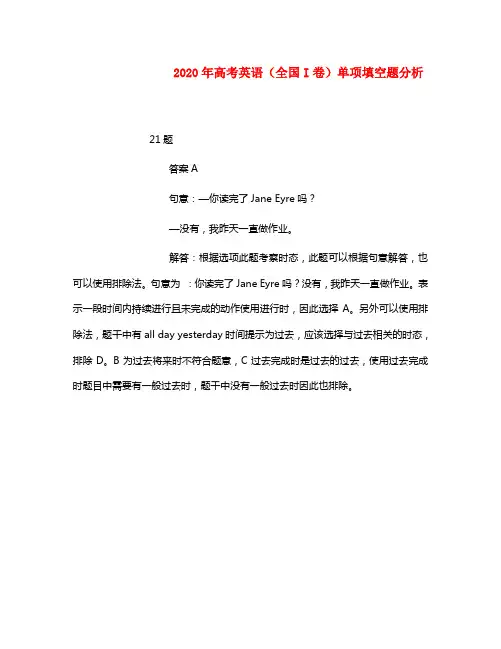
2020年高考英语(全国I卷)单项填空题分析21题答案A句意:—你读完了Jane Eyre吗?—没有,我昨天一直做作业。
解答:根据选项此题考察时态,此题可以根据句意解答,也可以使用排除法。
句意为:你读完了Jane Eyre吗?没有,我昨天一直做作业。
表示一段时间内持续进行且未完成的动作使用进行时,因此选择A。
另外可以使用排除法,题干中有all day yesterday时间提示为过去,应该选择与过去相关的时态,排除D。
B为过去将来时不符合题意,C过去完成时是过去的过去,使用过去完成时题目中需要有一般过去时,题干中没有一般过去时因此也排除。
28题答案:B句意:当你到家的时候,打电话给我让我知道你已经到家了。
解答:根据选项此题考察时态。
此题可以根据句意也可以使用排除法。
句意为“当你到家的时候,打电话给我让我知道你已经到家了”B选项使用现在完成时表示将来完成,译为“已经……”。
同时也可以使用排除法,arrive既可以使用现在进行时表示将来也可以用will+do表示将来,因此A和D同时排除,C为过去完成时,使用过去完成时时句中一定要有一般过去时,过去完成时是过去的过去,因此C也排除,选择B。
29题答案:A句意:耐心一点儿,你不能期望世界变化如此快。
解答:通过选项此题考察情态动词,can’t在否定句中可以表示推测,译为不可能,,可以表示能力,译为不能够,也可以表示命令,不允许,但是语气比mustn’t弱,具有劝慰的意思,根据句意此题中选择A,can’t表示劝慰。
30题答案:B句意:个小男孩儿不会睡觉除非他的妈妈给他讲故事。
解答:根据选项此题考察连词的用法。
O r译为“或者”表示选择,unless 译为“除非”表示条件,but译为“但是”表示转折,whether译为“是否”,根据句意选择A解答:根据选项此题考察非谓语动词。
题干中空格划在名词后,但是空格后的部分不是对bank解释说明,而是说明取钱的目的,因此此题中非谓语动词做目的状语,非谓语动词中不定式做状语用来表示目的,因此选择B。
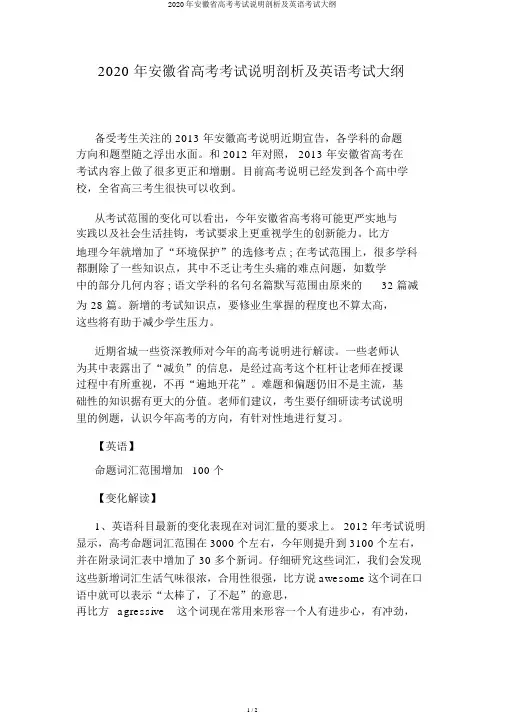
2020 年安徽省高考考试说明剖析及英语考试大纲备受考生关注的 2013 年安徽高考说明近期宣告,各学科的命题方向和题型随之浮出水面。
和 2012 年对照, 2013 年安徽省高考在考试内容上做了很多更正和增删。
目前高考说明已经发到各个高中学校,全省高三考生很快可以收到。
从考试范围的变化可以看出,今年安徽省高考将可能更严实地与实践以及社会生活挂钩,考试要求上更重视学生的创新能力。
比方地理今年就增加了“环境保护”的选修考点 ; 在考试范围上,很多学科都删除了一些知识点,其中不乏让考生头痛的难点问题,如数学中的部分几何内容 ; 语文学科的名句名篇默写范围由原来的32 篇减为28 篇。
新增的考试知识点,要修业生掌握的程度也不算太高,这些将有助于减少学生压力。
近期省城一些资深教师对今年的高考说明进行解读。
一些老师认为其中表露出了“减负”的信息,是经过高考这个杠杆让老师在授课过程中有所重视,不再“遍地开花”。
难题和偏题仍旧不是主流,基础性的知识据有更大的分值。
老师们建议,考生要仔细研读考试说明里的例题,认识今年高考的方向,有针对性地进行复习。
【英语】命题词汇范围增加100 个【变化解读】1、英语科目最新的变化表现在对词汇量的要求上。
2012 年考试说明显示,高考命题词汇范围在 3000 个左右,今年则提升到 3100 个左右,并在附录词汇表中增加了 30 多个新词。
仔细研究这些词汇,我们会发现这些新增词汇生活气味很浓,合用性很强,比方说awesome这个词在口语中就可以表示“太棒了,了不起”的意思,再比方agressive这个词现在常用来形容一个人有进步心,有冲劲,这些新增词反响了今年高考对考生语言运用能力和表达能力提出了新的要求。
2、2013 年英语科目考试说明对 2012 年的例题内容作了更换,选录了 2012 年全国各地和本省的高考题作为样题。
【复习建议】整体而言, 2013 年的考试说明除词汇范围外与 2012 年对照基本上没有变化,在剩下 80 多天的复习中,考生还是应该多做“中档题”,练习以动词为核心张开到相关的词汇、词组及句型,夯实WPS(words,phrases ,sentences 。
2020;2020山东省普通高等学校招生全国统一考试英语试题解析版本试卷分第Ⅰ卷和第Ⅱ卷两部分,共12页。
满分150分。
考试用时120分钟。
考试结束后,将本试卷和答题卡一并交回。
注意事项:1.答题前,考生务必用0.5毫米黑色签字笔将自己的姓名、座号、准考证号、县区和科类填写在答题卡和试卷规定的位置上。
2.第Ⅰ卷每小题选出答案后,用2B铅笔把答题卡上对应题目的答案标号涂黑;如需改动,用橡皮擦干净后,再选涂其他答案标号。
3.第Ⅱ卷必须用0.5毫米黑色签字笔作答,答案必须写在答题卡各题目指定区域内相应的位置,不能写在试卷上;如需改动,先划掉原来的答案,然后再写上新的答案;不能使用涂改液、胶带纸、修正带。
不按以上要求作答的答案无效。
第Ⅰ卷(共105分)第二部分英语知识运用(共两节,满分35分)第一节语法和词汇知识(共15小题;每小题1分,满分15分)从A、B、C、D四个选项中,选出可以填入空白处的最佳选项,并在答题卡上将该项涂黑。
21.Take your time-it’s just_____ short distance from here to_____ restaurant.A.不填;theB. a; theC. the; aD.不填;a解析:B.考查冠词。
句意:慢慢来,从这儿到旅馆只是一小段距离。
diastance 表一段距离用a, 如固定搭配 from a distance of.., 第二个空the restaurant 是两人都知道的事物,是特指。
22.-I’m sorry I broke the vase.-Oh,_____. It wasn’t very expensive.A. you’d better notB. I’m afraid notC. as you wishD. that’s all right解析:D.考查交际用语。
句意:对不起,我打碎了花瓶。
--哦,没关系,它不很贵。
2020年高考全国1卷英语试题解析解读分析work Information Technology Company.2020YEAR2020年高考全国1卷英语试题解析解读分析整体来说,2020年高考英语全国Ⅰ卷试题没有偏难怪题,话题充满时代感,词汇量有提升,符合英语学习重视词汇量、增加阅读量的趋势,以及英语命题注重基础性、综合性、应用性和创新性的规律。
今年试题的主要特点可以用“稳中有变”四个字来概括,只有在必备知识、关键能力、学科素养和核心价值四个方面都做好充分的准备,才能真正地考好英语。
具体来看,2020年高考英语全国Ⅰ卷的命题有以下特点:一、选材上,围绕人与自然、人与社会、人与自我三大主题全面考查英语综合运用能力。
阅读理解B篇阐述作者反复阅读自己所喜爱书籍的感悟,在重读中不断思考并提升自己;阅读理解C篇介绍竞走运动及其与跑步的不同之处,引导学生关注体育运动,提高锻炼意识;语法填空讲述嫦娥四号无人探测器在月球背面成功着陆的重大事件,展示了我国社会主义建设的新成就,切实增强“四个自信”;短文改错讲述作者第一次做西红柿炒鸡蛋的经历,引导学生在真实的生活体验中感受劳动的辛苦,尊重劳动、认同劳动,并愿意学习和参加劳动。
总的来说,今年试卷的选材依旧贴近学生生活,符合英语作为一门语言讲究实际应用的特点。
二、难度上,与去年相比略有下降。
一方面,阅读文章词汇量的要求仍然很高,一词多义、熟词生义、构词法、词块比比皆是,尤其是阅读理解B篇出现一些低频词和抽象名词;阅读理解D篇与去年相比难度略有下降,但文章中仍有很多派生词、合成词、学术词汇和长难句。
另一方面,设题上高度概括,对学生基于理解文章内容的基础上作出推理判断的能力要求有所提高。
另外,书面表达试题改变近年来常用的撰写书信或邮件形式,以命题作文形式结合具体的语言活动情境考查语言表达能力。
三、知识考查上,强调基础性、综合性和应用性。
语法填空和短文改错涉及的考点都侧重于基本用法,没有偏难怪题。
专题03 语言知识《2019年普通高等学校招生全国统一考试大纲》(英语)中有关语言知识的要求:要求考生掌握并能运用英语语音、词汇、语法基础知识以及所学功能意念和话题,要求词汇量为 3500 左右。
【解读】高考试卷对语言知识的考查主要体现于完形填空和语法填空。
核心语法,构建网络,不纠缠“偏难怪”词法、句法、章法是语法的灵魂,对于这三个要素要形成体系,不要支离破碎地学习,尽量掌握核心内容,不要把重心放在“偏难怪”且有争议的语法现象上。
可以制作一个语法知识本,以梳理核心语法知识,形成自己的知识网络,进而提升借助语法进行阅读和写作的能力。
如牢记常见的不可数名词,如advice, equipment, evidence, fun, furniture, information, luck, news, luggage/baggage, progress等牢记核心的词形变化,如warm—warmth, argue—argument, strong—strength, just—justice, unjust—injustice, explain—explanation等。
题型1 完形填空三年新课标卷完形填空试题分析全国卷对完形填空的考查,近几年来一直以记叙文和夹叙夹议文为主,以说明文和议论文为辅,2018年全国卷II和全国卷Ⅲ的完形填空就选用了记叙文,全国卷I采用了夹叙夹议文。
从选材到试题的设置都呈现出“稳中有变”的特点:1. 题材相对稳定:文章的选材都是中学生熟悉的话题,能够传递正能量,弘扬社会主义核心价值观,读后能给考生带来心灵的启迪。
且文章大多原汁原味,语言地道,注重思想性和教育性,具有积极的教育意义,体现出了课程标准中对培养学生的情感、态度和价值观的要求。
2. 文章短小精悍:完形填空的文章长度一般为250词左右,结构完整,脉络清晰,难度适中,全文设置20个空格,要求考生根据文章的整体内容,从层次结构和上下文的逻辑关系方面选择符合文章情节的选项,很少涉及纯语法知识试题。
2020年普通高等学校招生全国统一考试英语本试卷共150分,共14页。
考试结束后,将本试卷和答题卡一并交回。
注意事项:1.答题前,考生先将自己的姓名、准考证号码填写清楚,将条形码准确粘贴在条形码区域内。
2.选择题必须使用2B铅笔填涂;非选择题必须使用0.5毫米黑字迹的签字笔书写,字体工整,笔迹清楚。
3.请按照题号顺序在各题目的答题区域内作答,超出答题区域书写的答案无效;在草稿纸、试题卷上答题无效。
4.作图可先用铅笔画出,确定后必须用黑色字迹的签字笔描黑。
5.保持卡面清洁,不要折叠、不要弄破、弄皱,不准使用涂改液、修正带、刮纸刀。
第一部分听力(共两节,满分30分)做题时,先将答案标在试卷上,录音结束后,你将有两分钟的时间将试卷上的答案转涂到答题卡上。
第一节(共5小题,每小题1.5分,满分7.5分)听下面5段对话,每段对话后有一个小题,从题中所给的A、B、C三个选项中选出最佳答案,听完每段对话后,你都有10秒钟的时间来回答有关小题和阅读下一小题。
每段对话尽读一遍。
例:How much is the shirt?答案是C。
1What will the woman do this afternoon?A .Do some exercise. B. Go shopping. C. Wash her clothes.2Why does the woman call the man?A. To cancel a flight.B. To make an apologyC. To put off a meeting.3 How much more does David need for the car?A. $ 5,000.B.$20,000.C. $25,000.4 What is Jane doing?A. Planning a tour.B.Calling her father CAsking for leave.5 How does the man feel?A. Tied.B. Dizzy.C. Thirsty.第二节(共15小题;每小题1.5分,满分22.5分)听下面5段对话或独白。
专题08 情态动词和虚拟语气一、选择题1.—You didn't wait for Mr.Black last night, did you?—No, but we ________.He didn't return home at all.A.couldn't have B.needn't haveC.didn't need to D.should wait have2.Tom hasn't come to work since last Friday.________ he have had an accident?A.Must B.Should C.May D.Can【答案】D 【解析】疑问句的推测常可用can,一般不用must / may。
3.—How did you do in the test?—Not so well.I ________ much better but I misread the directions for writing.A.will have done B.could have doneC.must have done D.may have done【答案】B 【解析】but所表达的是一种含蓄条件,由其后的过去时态可知此处该用“could+完成时”的虚拟形式。
4.She quickened her pace in order that she ________ with the others.A.may catch up B.might catch upC.could have caught up D.might have caught up【答案】B 【解析】这是目的状语从句,由主句的过去时态可知此空该用情态动词的过去时。
5.If it were not for the fact that she ________ sing, I would invite her to the party.A.couldn't B.shouldn'tC.can't D.might not【答案】C 【解析】“她不能唱歌”是一客观事实,所以用现在时。
2020上海高考英语考试大纲及样卷上海作为全国进行高考自主命题的试点最早省市,上海教育考试院每年都会颁布上海高考考试大纲,即2020年全国普通高等学校招生统一考试上海卷英语科目考试说明,其作为上海高考英语命题的核心依据和教学复习的参考坐标。
特别是在高考临近的时候,学生往往采用“刷题思维”而不去研究高考英语考试大纲及其样题,学习的效果可能会不如预期!最好的策略应该是对高考英语考试大纲和样卷进行深度研磨,做到熟悉考纲,样题反思,针对高考真题进行反复研磨。
2020年普通高等学校招生全国统一考试(上海卷)英语科目考试说明一、考试性质、目的和对象普通高等学校招生英语科目全国统一考试(上海卷)英语科目考试是为普通高等学校招生而进行的选拔性考试。
选拔性考试是高利害考试,考试结果应该具有高信度,考试结果的解释和使用应该具有高效度。
考试命题的指导思想是有利于促进每一个学生的终身发展,有利于科学选拔和培养人才,有利于维护社会公平、公正。
考试对象是符合2020年上海市高考报名条件的考生。
二、考试目标依据《上海市中小学英语课程标准(征求意见稿)》和高校人才选拔要求,结合中学教学实际,高考英语科目旨在测试考生的英语基础知识和语言运用能力。
其中,着重语言运用能力的考核。
英语基础知识包括语音、词汇、语法、语言功能和话题。
语言运用能力指获取、理解信息的能力(听、读),按情景或要求表达思想、传递信息的能力(说、写)。
语言基础知识和听、读、写的具体测试目标为:I.语言基础知识主要测试考生对语言基础知识的掌握和运用能力,即:I.1能在语境中正确识别和理解不同语音、语调所表达的意义;I.2能在语境中正确理解和运用词汇知识;I.3能在语境中正确识别、理解和运用语法知识;I.4能在语境中正确理解和运用的交际功能。
听主要测试考生理解口头英语并运用相关知识完成任务的能力,即:II.5能获取话语中的事实信息;II.6能根据话语中的事实信息进行分析判断;II.7能推断话语中隐含的意思;II.8能归纳话语的主旨大意。
1 / 73 2020年高考英语考试大纲解读 一、语言知识 语言知识要求考生掌握并能运用英语语音、词汇、语法基础知识以及所学功能意念和话题,要求词汇量为 3500 左右。语言运用包括听力、阅读、写作和口语。 【解读】 短短数字,却蕴含了极大的信息量,高考所考的词汇、语法、话题等已全部包括。 牢牢抓住 “稳中有变,重在稳” 的特点 纵观近几年全国卷英语试题,皆基于英语
语音项目表 1. 基本读音 (1) 26 个字母的读音 (2) 元音字母在重读音节中的读音 (3) 元音字母在轻读音节中的读音 (4) 元音字母组合在重读音节中的读音 (5) 常见的元音字母组合在轻读音节中的读音 (6) 辅音字母组合的读音 (7) 辅音连缀的读音 (8) 成节音的读音 2 / 73
2. 重音 (1) 单词重音 (2) 句子重音 3. 读音的变化 (1) 连读 (2) 失去爆破 (3) 弱读 (4) 同化 4. 语调与节奏 (1) 意群与停顿 (2) 语调 (3) 节奏 5. 语音、语调、重音、节奏等在口语交流中的运用 6. 朗诵和演讲中的语音技巧 7. 主要英语国家的英语语音差异 【解读】 掌握英语语音对于听力理解和口语是非常重要的。 语法项目表 1. 名词 (1) 可数名词及其单复数 (2) 不可数名词 (3) 专有名词 (4) 名词所有格 2. 代词 3 / 73
(1) 人称代词 (2) 物主代词 (3) 反身代词 (4) 指示代词 (5) 不定代词 (6) 疑问代词 3. 数词 (1) 基数词 (2) 序数词 4. 介词和介词短语 5. 连词 6. 形容词(比较级和最高级) 7. 副词(比较级和最高级) 8. 冠词 9. 动词 (1) 动词的基本形式 (2) 系动词 (3) 及物动词和不及物动词 (4) 助动词 (5) 情态动词 10. 时态 (1) 一般现在时 (2) 一般过去时 (3) 一般将来时 (4) 现在进行时 (5) 过去进行时 (6) 过去将来时 (7) 将来进行时 (8) 现在完成时 (9) 过去完成时 (10) 现在完成进行时 11. 被动语态 12. 非谓语动词 (1) 动词不定式 (2) 动词的-ing 形式 (3) 动词的-ed 形式 13. 构词法 4 / 73
(1) 合成法 (2) 派生法 (3) 转化法 (4) 缩写和简写 14. 句子种类 (1) 陈述句 (2) 疑问句 (3) 祈使句 (4) 感叹句 15. 句子成分 (1) 主语 (2) 谓语 (3) 表语 (4) 宾语 (5) 定语 (6) 状语 (7) 补语 16. 简单句的基本句型 17. 主谓一致 18. 并列复合句 19. 主从复合句 (1) 宾语从句 (2) 状语从句 (3) 定语从句 (4) 主语从句 (5) 表语从句 20. 间接引语 21. 省略 22. 倒装 23. 强调 24. 虚拟语气 【解读】 以上语法项目包含了高中所学的重要语法项目,有利于高考备考。这些语法 5 / 73
项目常见于单项填空、语法填空、完形填空和短文改错等题型中。 核心语法,构建网络,不纠缠“偏难怪” 词法、句法、章法是语法的灵魂,对于这三个要素要形成体系,不要支离破碎地学习,尽量掌握核心内容,不要把重心放在“偏难怪”且有争议的语法现象上。可以制作一个语法知识本,以梳理核心语法知识,形成自己的知识网络,进而提升借助语法进行阅读和写作的能力。 如牢记常见的不可数名词,如advice, equipment, evidence, fun, furniture, information, luck, news, luggage/baggage, progress等 牢记核心的词形变化,如warm—warmth, argue—argument, strong—strength, just—justice, unjust—injustice, explain—explanation等。
1. 社会交往 (Social Communications) (1) 问候 (Greetings) (2) 介绍 (Introduction) (3) 告别 (Farewells ) (4) 感谢 (Thanks ) (5) 道歉 (Apologies) (6) 邀请 (Invitation) (7) 请求允许 (Asking for permission) (8) 祝愿和祝贺 (Expressing wishes and congratulations) (9) 提供帮助 (Offering help) 6 / 73
(10) 接受和拒绝 (Acceptance and refusal) (11) 约会 (Making appointments) (12) 打电话 (Making telephone calls) (13) 就餐 (Having meals) (14) 就医 (Seeing the doctor) (15) 购物 (Shopping) (16) 问路 (Asking the way) (17) 谈论天气 (Talking about weather) (18) 语言交际困难 (Language difficulties in communication) (19) 提醒注意 (Reminding) (20) 警告和禁止 (Warning and prohibition) (21) 劝告 (Advice) (22) 建议 (Suggestions) 2. 态度 (Attitudes) (23) 同意和不同意 (Agreement and disagreement) (24) 喜欢和不喜欢 (Likes and dislikes) (25) 肯定和不肯定 (Certainty and uncertainty) (26) 可能和不可能 (Possibility and impossibility) (27) 能够和不能够 (Ability and inability) (28) 偏爱和优先选择 (Preference) (29) 意愿和打算 (Intentions and plans) (30) 希望和愿望 (Hopes and wishes) 7 / 73
(31) 表扬和鼓励 (Praise and encouragement) (32) 责备和抱怨 (Blame and complaint) (33) 冷淡 (Indifference) (34) 判断与评价 (Judgement and evaluation) 3. 情感 (Emotions) (35) 高兴 (Happiness) (36) 惊奇 (Surprise) (37) 忧虑 (Worries) (38) 安慰 (Reassurance) (39) 满意 (Satisfaction) (40) 遗憾 (Regret) (41) 同情 (Sympathy) (42) 恐惧 (Fear) (43) 愤怒 (Anger) 4. 时间 (Time) (44) 时刻 (Point of time) (45) 时段 (Duration) (46) 频度 (Frequency) (47) 时序 (Sequence) 5. 空间 (Space) (48) 位置 (Position) (49) 方向 (Direction) 8 / 73
(50) 距离 (Distance) 6. 存在 (Existence) (51) 存在与不存在 (Existence and Non-existence) 7. 特征 (Features) (52) 形状 (Shape) (53) 颜色 (Colour) (54) 材料 (Material) (55) 价格 (Price) (56) 规格 (Size) (57) 年龄 (Age) 8. 计量 (Measurement) (58) 长度 (Length) (59) 宽度 (Width) (60) 高度 (Height) (61) 数量 (Number) 9. 比较 (Comparison) (62) 同级比较 (Equal comparison) (63) 差别比较 (Comparative and superlative) (64) 相似和差别 (Similarity and difference) 10. 逻辑关系 (Logical relations) (65) 原因和结果 (Cause and effect) (66) 目的 (Purpose) 9 / 73
11. 职业 (Occupations) (67) 工作 (Jobs) (68) 单位 (Employer) 【解读】 功能意念项目表所列项目中,常见的考试形式主要是听力和口语考试,听力考试在高考中所占分量很大,占总分值150分的五分之一(30分)。
话题项目表 1. 个人情况 (Personal information) 2. 家庭、朋友与周围的人 (Family, friends and people around) 3. 周围的环境 (Personal environments) 4. 日常活动 (Daily routines) 5. 学校生活 (School life) 6. 兴趣与爱好 (Interests and hobbies) 7. 个人感情 (Emotions) 8. 人际关系 (Interpersonal relationships) 9. 计划与愿望 (Plans and intentions) 10. 节假日活动 (Festivals, holidays and celebrations) 11. 购物 (Shopping) 12. 饮食 (Food and drink) 13. 健康 (Health) 14. 天气 (Weather)